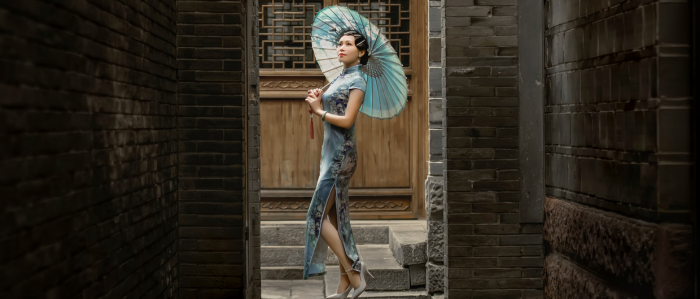
Qipao vs. Cheongsam
When it comes to traditional Chinese attire, the terms "qipao" and "cheongsam" often interchangeably come to mind. These elegant dresses, distinguished by their timeless beauty and intricate designs, have a rich cultural heritage that holds a special place in Singaporean culture. Let's delve into the nuances that set qipao and cheongsam apart, their cultural significance, and their evolution over time.
 (3).png)
Understanding the Qipao and Cheongsam, are they different?
"Qipao" and "cheongsam" are two terms often used interchangeably to refer to a traditional Chinese dress, but there are some distinctions between the two:
Qipao (旗袍):
- The term "qipao" primarily refers to the traditional Chinese dress for women.
- Qipao is a more modern term, and it was popularized in the early 20th century during the Republican era of China.
- The qipao is characterized by its slim-fitting design, high neck, and typically ends around the knees. It usually features a straight cut and a slit on one or both sides for ease of movement.
- It is often made of silk or other luxurious fabrics and is adorned with various decorative elements like embroidery, floral patterns, and intricate designs.
- The qipao can be worn for various occasions, including formal events, weddings, and even as everyday attire, depending on its style and fabric.
Cheongsam (長衫):
- The term "cheongsam" is more traditional and specifically refers to the dress worn by women in southern China, particularly in the Guangdong region, during the Qing Dynasty (1644-1912).
- The cheongsam features a more conservative and modest design compared to the qipao. It has a high collar, a fitted bodice, and a flared skirt that reaches the ankles. It does not have the characteristic side slits of the qipao.
- Traditionally, the cheongsam was made of cotton or other everyday fabrics and was worn as casual attire by women in southern China.
Today, the term "cheongsam" is often used to refer to the more traditional and vintage-style Chinese dresses, while "qipao" is used for the modern, slim-fitting variations. Both qipao and cheongsam refer to Chinese dresses for women, but qipao is a more modern and versatile style, while cheongsam is a more traditional and conservative design. The choice between the two depends on personal preference, the occasion, and the desired style. Both types of dresses are iconic representations of Chinese fashion and culture.
 (5).png)
Cultural Significance
Both the qipao and cheongsam hold significant cultural importance. They represent the evolving nature of Chinese fashion over time. The qipao, with its fusion of Eastern and Western styles, reflects China's openness to cultural exchanges, especially during the early 20th century. On the other hand, the cheongsam is a reminder of China's rich historical past and its regional diversity.
Today, these dresses continue to play a role in cultural celebrations and events. They are often worn during Lunar New Year festivities, weddings, and other special occasions, embodying a sense of tradition and pride in Chinese heritage.
Evolution and Contemporary Trends
In the contemporary fashion landscape, qipao and cheongsam have evolved to incorporate modern elements. Designers experiment with different fabrics, colors, and patterns, seamlessly blending traditional charm with a touch of modern flair.
At Fairebelle, for instance, we offer a variety of cheongsams patterns, including the timeless batik pattern, adding to the diversity of options available. This fusion of old and new has kept these dresses relevant and beloved.
 (Instagram Post (Square)) (1).png)
 (Instagram Post (Square)).png)
Styling Tips for Qipao and Cheongsam
Styling a qipao or cheongsam can be a delightful endeavor, as these dresses are not only rich in cultural heritage but also elegant and versatile. Whether you're wearing them for a special occasion or incorporating them into your everyday wardrobe.
Here are some styling tips to help you make the most of these iconic Chinese dresses:
- Perfect Fit - Ensure it fits well; tailoring may be needed.
- Classic Colors - Red, black, and navy are timeless, but feel free to experiment.
- Fabric Matters - Choose silk for formality, cotton for everyday wear.
- Accessories - Use jewellery, belts, hairpins, and handbags to complement the dress.
- Neckline - High for tradition, low for a modern twist.
- Footwear - Chinese slippers, heels, or flats can complete the look.
- Hairstyle - Consider classic updos or sleek hairdos.
- Keep Makeup Simple - Natural or classic makeup suits the elegance.
- Details Matter - Keep the dress well-maintained and wrinkle-free.
- Confidence - Wear it with pride; it's not just clothing but a statement of culture and grace.
Clearing Common Misconceptions
It's important to note that the terms qipao and cheongsam are often used interchangeably, leading to some confusion. While they share a common ancestry, the distinction lies in their specific features and the historical period they represent.
In conclusion, qipao and cheongsam both contribute to the rich tapestry of Singapore's cultural diversity. They offer a glimpse into the beauty of Chinese heritage, showcasing the blend of tradition and modernity that Singapore is known for. Whether you choose a qipao or a cheongsam, you're not just wearing a dress; you're embodying a piece of history, culture, and artistry that has endured through the ages. Celebrate this beautiful heritage in style and grace.
Key Takeaways: Qipao vs. Cheongsam
Qipao |
Cheongsam |
|
Description |
Modern Chinese dress for women | Traditional dress from southern China (Qing Dynasty) |
Design |
Slim-fit, high neck, knee-length, side slits | Fitted bodice, ankle-length, no side slits |
Fabric |
Often silk, luxurious | Traditionally cotton, everyday fabrics |
Occasions |
Versatile: formal, weddings, everyday | More traditional, vintage style |
Cultural Significance |
Represents modernity and cultural exchange | Reflects historical past and regional diversity |
Evolution |
Modern elements incorporated | Fused with modern flair, e.g., batik patterns |
